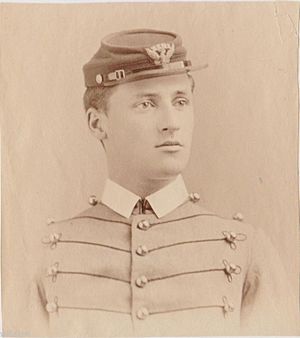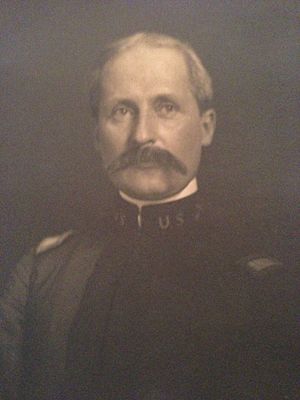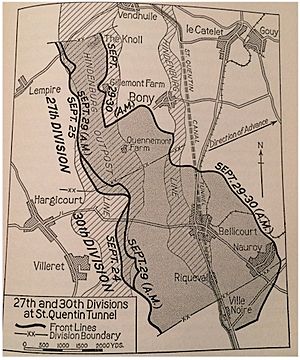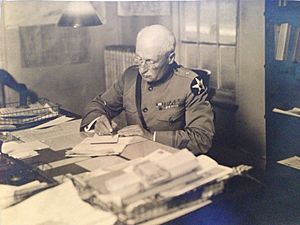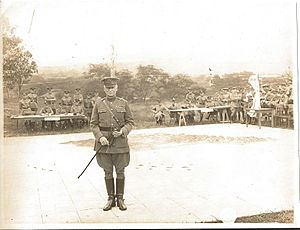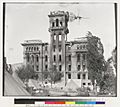Edward Mann Lewis facts for kids
Quick facts for kids
Edward Mann Lewis
|
|
|---|---|
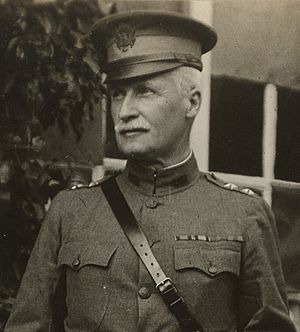 |
|
| Born | December 10, 1863 New Albany, Indiana, United States |
| Died | July 27, 1949 (aged 85) Oakland, California, United States |
| Place of burial | |
| Allegiance | |
| Service/ |
|
| Years of service | 1881 to 1928 |
| Rank | Major General |
| Service number | 0-55 |
| Commands held | Fort Wood, NY Statue of Liberty Plattsburgh, NY Old Stone Barracks 76th Infantry Brigade 38th Infantry Division The Paris Military District 3rd Brigade, 2nd Infantry Division 30th Infantry Division 5th Infantry Division The Douglas Arizona District 3rd Infantry Division 2nd Infantry Division 8th Corps Area Hawaiian Division The Hawaiian Department |
| Battles/wars | Spanish–American War Vera Cruz Moro Rebellion World War I Fourth Battle of Ypres Somme Hindenburg Line Battle of St. Quentin Canal Bellicourt Nauroy Vaux Selle River Campaign |
| Awards | Distinguished Service Medal Knight Commander of St. Michael and St. George – England Commander Legion of Honor – France Knight, Order of Leopold for Gallantry – Belgium Officer of the Order of Leopold II with Palm – Belgium Knight Commander, Order of Danilo – Montenegro World War I Victory Medal with 5 Battle Clasps Croix De Guerre – France (with 2 Palms) Croix De Guerre – Belgium (with Palm) Spanish Campaign Medal Army of Cuban Occupation Medal Mexican Service Medal Philippine Campaign Medal Society of the Army of Santiago de Cuba |
Major General Edward Mann Lewis (December 10, 1863 – July 27, 1949) was a brave and highly honored United States Army officer. He served his country for 46 years! During World War I, he led the 30th Infantry Division. This group helped break through the strong Hindenburg Line, which sped up the end of the war.
When he arrived in France in 1917, he was put in charge of all U.S. forces in Paris. In 1918, he led the 3rd Brigade of the 2nd Infantry Division. He planned and led a key attack on the town of Vaux near Château-Thierry. General John J. Pershing then promoted him to lead the 30th Infantry Division in July 1918. His leadership was a big reason for their success in the war.
Contents
Early Life and West Point Training
Edward Mann Lewis was born on December 10, 1863, in New Albany, Indiana. His father was a railroad executive who told him stories of their family serving in the military since the American Revolution.
Edward got into the West Point in 1881. He did very well in his classes and in sports. He became a cadet lieutenant in his first year. He struggled a bit with math, but his potential was clear. He joined the class of 1886 and became good friends with his classmate, John J. Pershing. This friendship lasted over 40 years! They served together in many places, including the Philippines, San Francisco, Mexico, and during World War I in Europe.
His time at West Point set him on a path of lifelong service. His stories even inspired his son, Henry Balding Lewis, to join the military. Henry also graduated from West Point in 1913 and became a major general in World War II.
Serving on the Frontier
After West Point, Edward Lewis became a second lieutenant in the infantry. He joined the 11th Infantry Regiment at Fort Yates in the Dakota Territory. After about a year, his unit moved to Fort Wood, on Liberty Island in New York harbor. The Statue of Liberty had just been put up, and Captain Lewis became its new commander.
His son, Henry Balding Lewis, was born there. He was the first child born at the new hospital on the island. The family then moved to Fort Huachuca in the Arizona Territory. Edward was very good at his job. He was given important duties usually given to older officers. He also taught Military Science at DePauw University in his home state.
Later, he led his men in the 9th Infantry Regiment. They helped end the Pullman Strike in 1894. This was a big railroad strike. To help calm things down, President Grover Cleveland made Labor Day a federal holiday that same year.
In 1896, he joined the 20th Infantry Regiment at Fort Leavenworth in Kansas. He stayed with this regiment for twelve years. He served as the regimental adjutant during the Spanish–American War and the Moro Rebellion in the Philippines.
Spanish-American War Hero
During the Spanish–American War, Lewis and the 20th Infantry Regiment fought in Cuba. Their main goal was to capture the city of Santiago de Cuba. American forces pushed back the Spanish defenses.
One important battle was the Battle of El Caney on July 1, 1898. U.S. troops faced strong resistance. Captain Lewis showed great bravery during this battle. He was recognized for his courage. During the war, Lewis met Theodore Roosevelt, who became a lifelong friend. Roosevelt later helped gather troops in Indiana for World War I.
After the fighting, Major General William Rufus Shafter began the siege of Santiago. Lewis was known for being calm under fire.
Service in the Philippines
After the Spanish-American War, Captain Lewis and the 20th Infantry Division went to the Philippines. This was for the Philippine–American War. They fought in many battles between 1899 and 1901. Lewis personally accepted the surrender of General Gregorio Aglipay in 1901. This brought peace to the northern part of the country.
He then returned to the Philippines in 1904 for two more years. This was during the Moro Rebellion. He worked at the headquarters in Manila. In 1906, his regiment returned home to San Francisco. They arrived just in time to help with a major disaster.
The San Francisco Earthquake
When the 1906 San Francisco earthquake hit, the city needed the Army's help. Captain Lewis was with the 20th Infantry Regiment at the Presidio in Monterey. They were called to help. General Funston took command of the city. Military districts were set up to manage the crisis.
The 20th Infantry was assigned to the Third Military District. They set up their command post at Portsmouth Square. They played a key role in bringing order back to the city. Their quick actions helped fight the fires and restore daily life.
In 1908, Lewis became a professor of military science at the University of California. In 1912, he was promoted to major. He then attended a special tactics course at Fort Leavenworth, graduating in 1913.
Duty in Mexico
After his course, Major Lewis commanded the 19th Infantry at Fort Meade, South Dakota. During the Mexican Revolution, his unit moved to Galveston, Texas, to guard the border.
In 1914, the United States invaded the port city of Veracruz in Mexico. This was due to a misunderstanding called the Tampico Affair. Lewis served as the Treasurer of the Military Government during this time.
Preparing for World War I
In 1915, Lewis worked with the Illinois National Guard. He was in charge of gathering troops for the state. The next year, he was promoted to brigadier general. He commanded a brigade of National Guard troops in Texas. His brigade included guardsmen from many states. As they prepared for war, he also worked at the Northeastern Department Headquarters.
World War I Service
Early in America's involvement in World War I, Lewis became a brigadier general in the regular Army. He commanded the 76th Infantry Brigade and later the 38th Infantry Division.
While his troops trained, General Lewis went to France. He was put in command of all U.S. forces in Paris. Many American soldiers were in the city. Paris became a separate military district under General Lewis in November 1917. He set rules for all American forces in the city. These rules helped keep order.
On May 5, 1918, he was assigned to command the Third Brigade of the 2nd Infantry Division. His troops helped stop the German advance outside Château-Thierry. This battle was part of the Hundred Days Offensive, which turned the war in favor of the Allies. General Pershing called Lewis's leadership a "Brilliantly executed operation" when his brigade captured the important town of Vaux on July 1.
A monument stands near Chateau Thierry to celebrate the victories of the 2nd and 3rd Infantry Divisions.
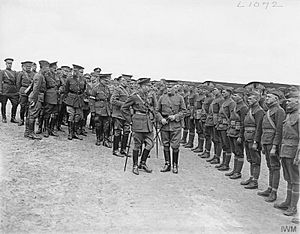
In July 1918, he was promoted to major general. He was then assigned to command the 30th Infantry Division. This division, nicknamed "Old Hickory," fought with the British Army. They broke through the strong Hindenburg Line on September 29, 1918. This happened at Bellicourt during the Battle of St. Quentin Canal. General Pershing praised their actions.
The 30th Division continued to fight hard. They pushed the Germans back seven miles to the Selle River by October 11. They then crossed the river and captured more towns.
Field Marshal Sir Douglas Haig, the British Commander, sent a letter praising the American divisions. He said they showed "energy, courage, and determination."
Lewis led the 30th Division until they returned to the United States in 1919. He stayed in France to lead the Infantry Board. This group studied the lessons learned from the war.
After the War
In July 1919, General Lewis commanded the 5th Division in Georgia. Then he was in charge of the Douglas Arizona District. He later led the 3rd Division, known as "The Rock of the Marne," in Arkansas. He also commanded his beloved "Indianhead" 2nd Infantry Division in Texas. He helped start Army Aviation there.
In December 1922, he was promoted to command the 8th Corps. This was the largest Army group in the United States at the time. His son, Major Henry Balding Lewis, joined him in Texas. During this time, the Army began to use more machines instead of horses for cavalry.
Leading in Hawaii
In 1924, General Lewis was chosen to command the Hawaiian Division. In January 1925, he took charge of the Hawaiian Department. While in Hawaii, General Lewis oversaw the largest military exercises in U.S. history up to that point. The Army practiced defending the islands from a naval invasion.
In 1927, he visited China. He saw the Marines and the Army's 15th Infantry Regiment there. He also saw his son, Henry Balding Lewis, who was serving in China. Henry's wife and their daughter, Frances, were also there.
General Lewis ran the Hawaiian Department until he retired in December 1927. He had served his country for 46 years!
After traveling the world to visit friends, Major General Edward Mann Lewis and his wife settled in Berkeley, California. He died on July 27, 1949, and was buried at the San Francisco National Cemetery.
Awards and Honors
| Army Distinguished Service Medal | |
| Spanish Campaign Medal | |
| Mexican Service Medal | |
| Army of Cuban Occupation Medal | |
| Philippine Campaign Medal | |
| World War I Victory Medal with 5 Battle Clasps | |
| Knight Commander, Order of St Michael and St George (England) | |
| Commander, Legion of Honor (France) | |
| Order of Leopold (Belgium) | |
| Order of Leopold II (Belgium) | |
| Knight Commander, Order of Prince Danilo I (Montenegro) | |
| Croix de Guerre with 2 Palms (France) | |
| Croix de Guerre with Palm (Belgium) | |
 |
Society of the Army of Santiago de Cuba |
Images for kids


